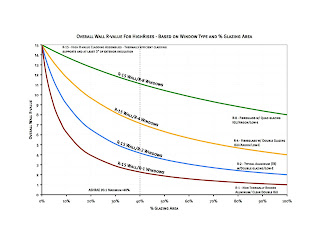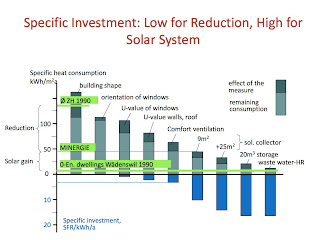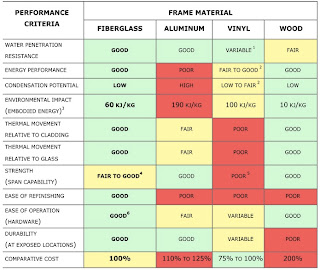Midorihaus Passive House Windows
It’s important readers! High performance windows tuned to the climate and the compass orientations of the building envelope area are a critical part of the Passive House architectural approach. In our case the glazing area comprises [290ft2/ 1700ft2] or about 17% of the total wall area. The holy grail of window thermal performance is R factor, which is a measure of heat resistance related to the heat transfer per unit area per degree temperature difference from interior and exterior. In the US it has units of (ft²·°F·h)/Btu and is known as R-value. In the rest of the world, window performance is quantified in metric units by a measure of thermal transfer efficiency known as U-factor which is inversely proportional to R-value and whose units are W/(m²·°K). You can see the impact of windows’ thermal performance (R-value) on the overall wall assembly as a function of % glazing area from this graph:

The process of choosing our Passive House windows was quite involved. We were not only trying to achieve the best cost-performance from the window itself but were also wishing to improve the Bungalow aesthetic of our home by adding simulated divided lites (SDLs) known in the past as “muntins.” The original 1920’s architect employed single pane windows throughout the house without muntins. Divided lites are however a key stylistic hallmark of the Bungalow. The opportunity to add this important Bungalow stylistic feature made removing the old single pane lead crystal less regrettable.
Throughout our project we wanted to source materials as locally as possible. However the very best performing windows are European. This also means they have a huge embedded energy resulting from the considerably long shipping distance. High quality European triple glazed windows are generally fabricated from timber sustainably forested in the EU. Wood windows may have as little as 1/6 the embodied energy compared to fiberglass windows and 1/10 the embodied energy compared to vinyl windows. However even with this high performance their total life cycle back time would be largely compromised in the short term because of the embodied freight energy.
Lower cost domestic vinyl windows not only have very high embodied energy but also have significant environmental impacts on air quality (dioxins) during manufacture. Other American windows such as Marvin (wood) or Serious Windows (fiberglass) either offered lower thermal performance or a more limited range of coating options for tuning the glazing to the installed compass orientation to maximize passive solar heat gains for our project.
To complicate matters further there is a significant difference in window performance testing and verification between the continents. European windows are rigorously modeled for performance. However in Europe a physical example of the window is not actually tested by a 3rd party for performance verification as in United States via the National Fenestration Rating Council (NFRC) certification. One cannot understate the importance of physical verification of modeled performance.
The graph below (ZehnderUSA) shows the overall cost efficacy of the subcomponents of Passive House features. The Specific heat consumption numbers shows that, after building orientation, window performance constitutes the largest chunk of energy savings for a building. The cost efficacy units in blue are FR/kWh/a or (Swiss Francs per kWh per annum) savings and show that investing in the best possible windows is a no brainer from the perspective of energy efficiency payback.

We also see that after the investment in high performance windows, increasing the insulation of the exterior shell and employing a heat recovery ventilator (HRV) or energy recovery ventilator (ERV) are the next wisest dollars spent.
Yes, investing in high performance windows is a good investment provided they can provide a lasting energy savings over less expensive but lower performing windows. However the coastal climate of Santa Cruz involves wide swings in outdoor relative humidity levels, precipitation, drizzling fog, and extended intense direct sun & UV due to generally high ambient air quality. This is a stress factor for wood window frame materials and necessitates more frequent resurfacing/repainting even though wood frames are the most sustainable material for window frame fabrication from the perspective of embodied energy. Termites need also be considered as a risk factor with wooden windows.
This is a graph from the Canadian manufacture of pigmented fiberglass windows (Cascadia) we ultimately chose for the project. It is vendor-formatted data you have to take it with a grain of salt but I believe is in general faithful to the facts. It compares many performance attributes of the four different windows frame material types commonly available.

So why did we choose this vendor Cascadia over the rest? This can be seen from the graph below which compares cost and various performance criteria for several vendors:

Simply put, energy efficient buildings minimize reliance on artificial lighting. To achieve this they maximize the amount of natural light admitted into the building interior through their windows. As a result energy efficient buildings enjoy high natural lighting efficacy. Energy efficient buildings also need to retain interior heat very efficiently at night and during cold seasons. For windows to accomplish all this at once requires special optical coatings which transmit in the light we see (visible light) while controlling or reflecting invisible heat energy (short wave infra-red) from the inside out and from the outside in. Different vendors offer different solutions but generally a thin layer of metallic silver is deposited onto the inner surfaces of the outmost glass and the cavity is filled with an inert gas such as Argon to prevent future tarnishing of the silver. One exception is Serious Windows whose products offer good thermal performance but rely on an inner polymer film to control Solar Heat Gain Coefficient (SHGC). SHGC is the measure of the amount of short wave infrared that passes through the window from the exterior. If the SHGC is too high and there is no effective roof overhang or shading this can contribute to high summertime HVAC loads, especially in climates with a high CDD (Cooling Degree Day) load. You learn more about HDD and CDD here: http://en.wikipedia.org/wiki/Heating_degree_day. Maps for the US are here: http://en.wikipedia.org/wiki/File:United_States_Heating_Degree_Day_map,_1961-1990.jpg and here: http://en.wikipedia.org/wiki/File:United_States_Cooling_Degree_Day_map,_1961-1990.jpg.
In the case of the Serious Windows approach, the windows were dimmer that other vendors with comparable SHGC. In quantitative terms this means they are lower in natural lighting efficacy due to lower Visible Transmittance or VT, which is the ratio of the light ultimately getting through the window expressed as a fraction of the total visible light reaching the exterior of the window. Serious Windows uses internal, non-ceramic thin films between the outer glass panes, which are also absorptive in the ultra-violet band. Ultra violet light chemically alters many hydrocarbon-based materials over time. This approach may not prove as durable as triple glazed with all ceramic glass although, however in all fairness, Serious Materials offers a life warranty on their windows. The Marvin triple glazed windows are not as well performing as either the Cascadia or the other European triple glazed offerings. The Cascadia windows offer a higher Solar Heat Gain Coefficient, higher VT (more light gets indoors), and somewhat better thermal performance (lower U value) than the Marvin Windows but to not quite attain performance the European vendors. It should be mentioned the Marvin Windows had some nice features such as optional built-in bug screens and SDLs that looked very nice in the show room.
The European windows we saw on tours were, as expected, beautiful and extremely well built. Many offer an aluminum cladding over the wood frames. The Sorpetaler windows were quite impressive as seen in two other Bay Area Passive Houses. However, all of the European windows would have been burdened with very high embedded shipping energy. Since we also considered global warming potential when selecting our insulation materials we thought being consistent with the windows too would serve the overall desired project outcomes. The Cascadia windows were the best overall balance of desired outcomes at the time of our project. However this will likely change and hopefully more domestic alternatives for Passive House projects will become available domestically. The American made wooden H and H windows were very cost competitive to Cascadia. From a sustainability perspective H and H seemed an ideal choice with lower transport embodied energy (made in the US) and lower embodied manufacturing energy (wooden frames). But at the time of our project H and H had no NFRC certification. That was too high of a risk to assume since we would only learn of any shortcomings in air sealing after installation. A final vendor comment..the Inline window rep kept trying to steer us away form triple pane and towards a high performance double pane option.
This brings us to a final discussion point. Why triple paned in the comparably mild climate of Santa Cruz CA? Three reasons (1) enhanced street noise attenuation (2) enhanced winter comfort due to higher indoor glass surface temperature (3) best bang for the buck in energy savings. The fact of the matter is that once you are working with a vendor who can satisfy the air tightness requirement and window frame R values needed for a Passive House you are in a price range where much of what you are paying is for the overall build quality and engineering. The marginal savings of a few thousand dollars do ‘downgrade’ to double pane glass didn’t seem with it when considering the ancillary comfort benefits.
Getting your Passive House windows right will be an in depth exercise for the homeowners and designers requiring tremendous attention to detail and patience in working with the vendors. It is critical to ensure that the correct coatings are incorporated in each window to ensure that window’s performance relative to its compass orientation NSEW. Customer service is sometimes lacking. Be fore-warned! Our issues involved trying to avoid the ‘grilles between glass’ or GBG with our SDLs. We were unable to get a different color SDL adhesive (which adheres the SDL bar to the exterior glass surfaces). This meant using aluminum bars between the #2 and #3 glass surface to avoid the awkward visual gap when looking though the windows from an angle. The Cascadia GBG bars are thermally broken as they intercept the divider at the edge of the glass. We have been told the thermal performance as modeled by the glass unit manufacture (Cardinal USA) is not appreciably affected. We have yet to receive the exact modeling for our project..story continued.
About the Author
Chie Kawahara
Chie is one of the co-creator of Midori Haus. When she is not sharing her stories of transforming an old house and giving tours, she enjoys trail running and hiking.
Hi, just wanted to tell you, I enjoyed this post. It was inspiring.Keep on posting!
Your blog is awesome and really helpful for readers. The Eco Refurbishment is a London based environmental construction company.
Thanks for your great information. We all appreciate your information. Keep posting these kind of nice blogs.
Fiberglass Windows Installation Company
Sorry, are those graphs available somewhere? I notice you responded, but am not sure that anything was added.
Thanks for the help!
BTW, for the Intus windows, quoted from GreenBuildingAdvisor.com: "The high-quality Premmier windows, Premmier Passiv, are certified by the Passivhaus Institut in Darmstadt, Germany. These Passivhaus-certified windows cost about $95 to $100 a square foot for triple-glazed operable windows. Passivhaus-certified windows include a layer of insulation between the wood frames and the exterior aluminum cladding." It seems the Premmier Passiv windows are wood-framed windows, so I would suspect the uPVC windows are even less…
Sorry for the late response on the graph requests.
The Intus windows seem to have staggering performance. I wonder how their cost per square foot would compare with Cascadia? For our project I believe that was ~$140/SQFT for a total of 18 triple glazed windows and 3 triple glazed doors with moderately complicated muntins on all.
Did you look at Intus Windows and the uPVC steel reinforced Passive House series?
Hi Kurt-
When you click on the tables above, nothing happens and they are too small here to be legible. I'd love to see the comparison of window values in the last table above.
I don't suppose you plan to post some photos of your new windows and how you installed them? Thanks for sharing! Great thanks, Jonathan (jkaplan@nrdc.org)
Thanks for the article Kurt! It's a bit difficult to see each of the graphs and charts included. Would you mind e-mailing me the full-res versions? You can reach me at mattockandrew@gmail.com. Thanks agian!
Bronwyn. Thank you for your comments and especially the link! Those are surprising and amazing numbers on transport related emissions.
Great article Kurt. It's wonderful to share this journey with you and Chie. One minor comment regarding the transportation carbon footprint though. Importing goods can sometimes actually have a lower impact than buying them in the US due to the efficiency of shipping containers vs diesel trucking. For an exact calculation of your ordered product, crunch the numbers using this handy calculator: http://www.maerskline.com/globalimage/?path=/about_us/table_of_comparison. You may be very surprised by what you find!